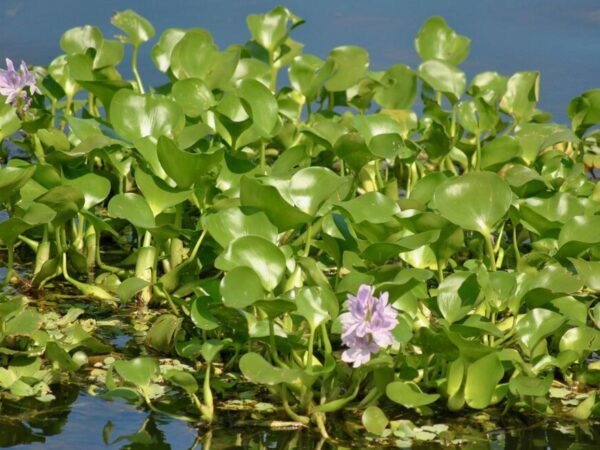
Water Hyacinth
(Eichhornia crassipes)
Species at a Glance
Water Hyacinth is a free-floating flowering perennial plant that forms dense mats in the water which can cover the surface of a lake or pond. Its beauty makes it a popular ornamental plant for ponds; however, its fast growth makes it one of the worst aquatic weeds in the world, as it can double its population in as little as six days.
Species Description
The leaves of Water Hyacinth are oval, rounded, circular, or elliptical, and are arranged in rosettes on stalks that can rise 0.9 m (3 ft) above the water’s surface. They are thick, glossy, waxy green, and typically up to 15 cm (6 in) wide. The edges of the leaf are wavy, and the base is heart-shaped, square, or rounded with dense veins.
Water Hyacinth produces 8 to 15 flowers that form in a single spike growing up to 30 cm (12 in) long atop a thick stalk. Each showy flower in the spike has six lavender-blue petals. The uppermost petal is somewhat larger with a bright yellow, blue-bordered, central spot. A three-celled capsule contains thousands of seeds.
The stem grows up to 0.5 m (1.5 ft) long and is filled with air spaces, which gives it a spongy appearance and allows it to stay afloat. Fibrous roots hang submerged beneath the floating leaves. They are dark purple to black and have a feathery appearance.
Water Hyacinth can be confused with American Spongeplant because of its similar looking leaves; however, American Spongeplant has white roots instead of black and has a slender, ridged stem instead of bulbous, inflated stem. It can also be confused with Water Lettuce, which has large, ribbed leaves and lacks showy flowers.
Native & Introduced Ranges
Native to Brazil, Water Hyacinth is now found in more than 50 countries on five continents. It is believed to have been introduced to the United States in 1884 for the Cotton States Exposition held in New Orleans and was given as gifts to attendees who took it home to add to backyard ponds. By 1900 it had escaped cultivation to become a serious pest.
Biology & Spread
Deliberate release and escape from water gardens have been major modes of dispersal for Water Hyacinth. Once introduced, its high growth rate allows it to quickly establish and spread. It reproduces both by fragmentation and by forming plantlets at the end of a shoot that grows from the base of the stem. Water Hyacinth produces up to 3,000 seeds per flower stalk, which can remain viable for more than 28 years.
Habitat
Water Hyacinth grows in shallow temporary ponds, wetlands, marshes, sluggish-flowing waters, lakes, reservoirs, rivers, and ditches of temperate climates. It can tolerate extremes in water level fluctuations and seasonal variations in nutrients, pH, temperatures, and toxins. It is not winter hardy and needs temperatures above 12°C (54°F) to survive.
Impacts
Threat to Biodiversity
Dense, impenetrable mats prevent sunlight and oxygen from penetrating the water column and the submerged plants below, shading out native species and reducing biodiversity. Water Hyacinth also has a high evapotranspiration rate, meaning it loses water to the atmosphere at a rate up to six times that is lost by open water.
Economic Costs
Water Hyacinth forms thick mats that block waterways and limit boat traffic, swimming, fishing, and other recreational activities. In drainage and irrigation canals, it impedes flow, which can result in flooding and clogged pumps.
Prevention & Control
Eradication of Water Hyacinth is difficult because of its rapid growth rate and its long-lived seeds. Chemical and mechanical control measures have been used for Water Hyacinth control since the early 1900s, but they are expensive and often ineffective on all but small infestations.
Preventing the introduction and spread of Water Hyacinth is the best way to protect natural habitats from harm.
- Know how to identify and report Water Hyacinth.
- Always check for and remove plants, mud, and debris from boats, trailers, clothing, and equipment before entering a water body and before leaving a water body.
- Drain all water from bait buckets, bilges, and live wells before transporting to new areas.
- Clean all gear and equipment with hot water (140°F or 40°C) or salt water, OR let boats and equipment dry thoroughly for at least five days before entering a new water body.
- When choosing plants for a pond or water garden, purchase from a licensed nursery and choose regionally native or non-invasive plants. Check with your state natural resource agency to confirm which plants to avoid for your region.
Resources:
- Sullivan, P.R., Wood, R. 2012. Water hyacinth (Eichhornia crassipes (Mart.) Solms) seed longevity and the implications for management. Eighteenth Australasian Weeds Conference.
- Ramey, V. 2001 Eichhornia crassipes. University of Florida Center for Aquatic and Invasive Plants.
- Global Invasive Species Database (2016) Species profile: Eichhornia crassipes.
- ImapInvasives (2021)



